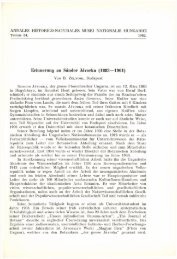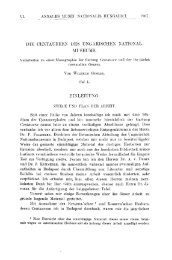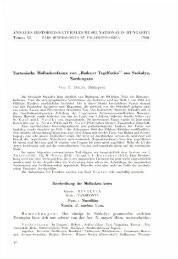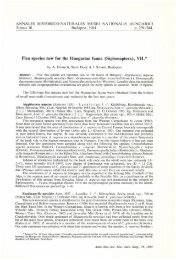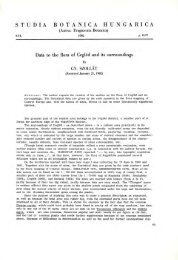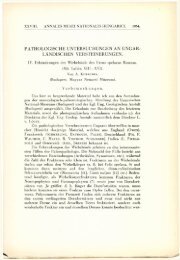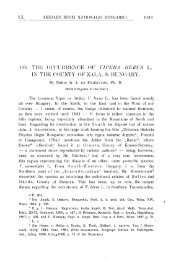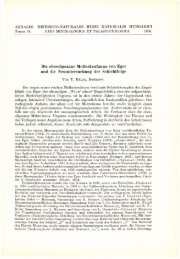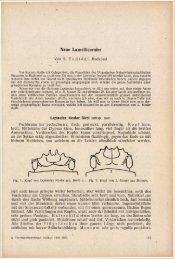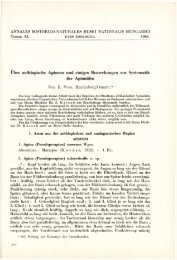Two new trematode species from freshwater fishes of Peninsular ...
Two new trematode species from freshwater fishes of Peninsular ...
Two new trematode species from freshwater fishes of Peninsular ...
Create successful ePaper yourself
Turn your PDF publications into a flip-book with our unique Google optimized e-Paper software.
P8l'88it. hung. 17. 1984<br />
<strong>Two</strong> <strong>new</strong> <strong>trematode</strong> <strong>species</strong> <strong>from</strong> <strong>freshwater</strong> <strong>fishes</strong><br />
<strong>of</strong> <strong>Peninsular</strong> Malaysia<br />
Dr. Susan LIM LEE BONG· -<br />
Dr. Juan I. FURTADO<br />
University Malaya, Lembah Pantai, Kuala Lumpur, Malay8ia<br />
"<strong>Two</strong> <strong>new</strong> <strong>trematode</strong> <strong>species</strong> <strong>from</strong> <strong>freshwater</strong> fishe s <strong>of</strong> <strong>Peninsular</strong> Malaysia" -<br />
Lim Lee Hong, S. - Furtado, J.I. - Parasit. "hung., !2.. 37-44.1984.<br />
ABSTRACT. <strong>Two</strong> <strong>new</strong> <strong>species</strong> <strong>of</strong> <strong>trematode</strong>s have been obtained <strong>from</strong> four <strong>species</strong><br />
<strong>of</strong> <strong>freshwater</strong> fishe s -in <strong>Peninsular</strong> Malaysia. They are He lostornatis cypri<br />
~ sp. n. <strong>from</strong> Labiobarbus festiva and Osteochilus melanopleura and Singhia<br />
kruinensis sp. n. <strong>from</strong> Notopterus chitala and N. notopterus.<br />
KEY WORDS. Trematoda, Helostomatis cyprinorum sp. n., Singhia kruinensis<br />
sp.n., <strong>freshwater</strong> fishe s, ecology, <strong>Peninsular</strong> Malaysia.<br />
INTRODUCTION<br />
There are at present only two recorded <strong>species</strong> <strong>of</strong> <strong>freshwater</strong> fish <strong>trematode</strong>s <strong>from</strong> <strong>Peninsular</strong><br />
Malaysia: Orientocreadium batrachoides Tubangui, 1931 (Furtado et Lau 1968) and Transversotrema<br />
patialense Soparkar, 1924 (Betterton 1979). These two <strong>new</strong> <strong>species</strong> will thus increase<br />
the number <strong>of</strong> recorded <strong>species</strong> <strong>of</strong> <strong>trematode</strong> to four. <strong>Two</strong> other <strong>trematode</strong> <strong>species</strong>, a<br />
Phyllodistomum <strong>species</strong> and a Haplorchoides <strong>species</strong>, were collected <strong>from</strong> Mystus nemurus<br />
(Bagridae); but due to the low number <strong>of</strong> specimens collected, these two <strong>species</strong> will not be<br />
described until more specimens are be obtained.<br />
MA TERIALS AND METHODS<br />
The host <strong>species</strong> <strong>of</strong> the two <strong>new</strong> <strong>species</strong> were obtained <strong>from</strong> Tasek Bera, a <strong>freshwater</strong> inundated<br />
swamp forest in <strong>Peninsular</strong> Malaysia. The parasites collected were treated for whole<br />
mount morphological studies: they were flattened between a glass slide and coverslip or two<br />
glass slides depending on the size <strong>of</strong> the <strong>trematode</strong>s, fixed in Bouin's solution, stored in 70%<br />
alcohol and stained in the laboratory following procedures recommended by FERNANDO et al.<br />
(1972).<br />
AU the measurements are given in millimeter (mm.), with the averages followed by the ranges<br />
in parentheses.<br />
Description<br />
Helostomatis cyprinorum sp. n. (Paramphistomidae) (Fig. 1).<br />
Hosts: Labiobarbus festiva (Heckel) (Cyprinidae) (Type host)<br />
Osteochilus melanopleura (Bleeker) (Cyprinidae)<br />
·Part <strong>of</strong> the preparation <strong>of</strong> this report was done by the senior author during her visit to Hungary<br />
in 1979.<br />
37
Locality: Tasek Bera, Pahang.<br />
No. <strong>of</strong> specimens studied: 10 specimens <strong>from</strong> L. festiva and 5 specimens <strong>from</strong> O. melanopleura.<br />
Type specimens: Holotype (UMT 1) and pa ratypes (UMT 1 et 2) are deposited in the Department<br />
<strong>of</strong> Zoology, University <strong>of</strong> Malaya, Kuala Lumpur.<br />
Body oval to elliptical, ends bluntly rounded with posterior slightly broade r than the ante rior,<br />
length 1.88 (1.58-2.04) and width 1. 09 (0.89-1.28). Cuticle smooth, without spines. Pha rynx<br />
terminal surrounding mouth, length 0.20 (0.14-0.27) and width 0.20 (0.11-0.21). Acetabuium<br />
posterior, subterminal, larger than oral sucker, length 0.44 (0.35-0.60). width 0.46 (0.29-<br />
0.64). Oe sophagus; length 0.29 (0.21-0.43), width 0.07 (0.05-0.08). On either side <strong>of</strong> prepharynx<br />
short, stout muscular primary pharyngeal sacs, length 0.24 (0.18-0.27), width 0.08<br />
(0.04-0.11). Extending <strong>from</strong> the primary pharyngeal sacs blind convoluted diverticular<br />
pouches, length 0.42 (0.32-0.53). width 0.27 (0.21-0.35). filling the space between prepharynx<br />
and esophageal bulb. Esophageal bulb elongated, transversely striated, length 0.50<br />
(0.48-0.53), width 0.14 (0.13-0.16). Intestinal bifurcation beginning at a distance <strong>of</strong> 0.67<br />
(0.56-0.78) <strong>from</strong> anterior end. Caeca continuing late rally then posteriorly, resulting in the<br />
caeca having a 3-shaped configuration. Caeca terminate about 0.34 (0.21-0.64) above posterior<br />
end.<br />
<strong>Two</strong> oval-lobulate testes, situated at 0.96 (0.85-1.01) <strong>from</strong> anterior, in pre-ovarian field.<br />
Vas efferens not distinct. Single vas deferens opening into cirrus sac just before bifurcation<br />
<strong>of</strong> intestine. Large cirrus sac situated between genital sucker and bifurcation <strong>of</strong> inte stine,<br />
length 0. 18 (0.16-0.19), width 0.07 (0.04-0.10). Seminal vesic1e internal and convoluted.<br />
Glandular cells <strong>of</strong> pars prostatica observed just before gen ital opening. Cirrus opening into<br />
common genital atrium.<br />
Ovary ovoid, situated medially between testes and acetabulum, in posterior one-third <strong>of</strong> body,<br />
length 0.07 (0.05-0.15), width 0.08 (0.05-0.19). Ootype extending latero-posteriorly, Laurer'<br />
s canal small. Mehlis' gland not distinct. Follicular vitellaria lateral, extracaecal with<br />
vitelline ducts entering ootype laterally. Coiled uterus extending anteriorly in intercaecal<br />
field, ending in an enlarged metraterm which opens into the genital atrium. Eggs embryonated<br />
length 0.13 (0.11-0.14), width 0.07 (0.06-0.08).<br />
Differential diagnosis<br />
This <strong>new</strong>ly described <strong>species</strong> belon gs to the genus Helostomatis (Fukui 1929) Travassos,1934<br />
(Family: Paramphistomatidae Fischoeder, 1901; subfamily Helostomatinae Skrjabin, 1949).<br />
Hitherto there had been only three <strong>species</strong> described for this genus: Helostomatis helostoma_<br />
tis (MacCallum 1905) Travassos 1934 <strong>from</strong> Helostoma temmincki (Sumatra). H. sakrei Bhalerao,<br />
1937 <strong>from</strong> Labeo calbasu (India) and H. cirrhini Gupta and Kumari, 1970 <strong>from</strong> Cirrhina<br />
mrigala (India). All these <strong>species</strong> are parasites <strong>of</strong> the alimentary system <strong>of</strong> cyprinids<br />
in the Oriental zoogeographical region.<br />
The present <strong>species</strong> differs <strong>from</strong> H. helostomatis in having larger diverticular pouches and<br />
3 -shaped caeca. The 3 -shaped caecal arrangement (after bifurcation caeca curving sinuously<br />
giving a 3 -shaped structure) is recorded in all the specimen s studied. H. sakrei is different<br />
<strong>from</strong> the present <strong>species</strong> in having trilobed ovary, straight caeca and smaller diverticular<br />
pouches. H. cirrhini is diffic,ult to analyse because <strong>of</strong> its incomplete description which is<br />
without drawing (since the description given is only a resumé) (GUPTA end KUMARI 1970"<br />
however it differs <strong>from</strong> the present <strong>new</strong> <strong>species</strong> in the caeca terminating at the level <strong>of</strong> the<br />
ovary, the testes being diagonal, and the shape <strong>of</strong> the ovary which is presumably trilobed.<br />
Gupta and Kumari (1970) reported that there is no genital sucker in H. sakrei <strong>from</strong> Labeo<br />
dero but only a gen ital atrium lined with sphincter muscles.<br />
Based on these differences the present <strong>species</strong> is considered a <strong>new</strong> <strong>species</strong>, and iE. named<br />
Helostomatis cyprinorum because <strong>of</strong> its occurrence in cyprinid <strong>fishes</strong>.<br />
38
0.0<br />
O.S<br />
Fig. 1: Composite illustration <strong>of</strong> Helostomatis cyprinorum sp. n.<br />
39
.The specimens obtained <strong>from</strong> O. melanopleura are larger and the caecal configuration less<br />
3 -shaped. This may possibly be due to the relaxed state <strong>of</strong> the worm, however the measurements<br />
obtained for the other features showed that this is not so. Since the Helostomatis <strong>species</strong><br />
in both cases are mature specimens, the age <strong>of</strong> the worm is eliminated as a possible<br />
cause <strong>of</strong> variation. The differences in size may be due to adaptation to different microenvironment,<br />
especially since Osteochilus melanopleura is a comparatively much larger fish<br />
than Labiobarbus festiva. Except for these differences, the Helostomatis <strong>species</strong> collected<br />
<strong>from</strong> O. melanopleura is very similar to those found in L. festiva, and is considered the<br />
same <strong>species</strong> as Helostomatis cyprinorum sp. n .<br />
Amendments to the genus Helostomatis (Fukui, 1929) Travassos, 1934.<br />
The gene ric (Helostomatis) and subfamilial (Helostomatinae Skrjabin, 1949) characteristics<br />
should be amended in the light <strong>of</strong> the discovery <strong>of</strong> the <strong>new</strong> <strong>species</strong>, because a few characteristic<br />
s are que stionab1e mo rphologically:<br />
(1) The description <strong>of</strong> the acetabuium being "wider than posterior end <strong>of</strong> bOGy proper, with<br />
its aperture drawn out late rally and curved backward" (Y AMAGUTI. 1971 p . 47) should be<br />
deleted because this is not a gene ric characteristics, but rather a specific characteristics<br />
<strong>of</strong> H. helostomatis, since this feature is not observed in any <strong>of</strong> the recorded <strong>species</strong> <strong>of</strong><br />
the genus (se e H. sakrei Bhalerao, 1937; H. cirrhini Gupta and Kumari, 1970; and present<br />
<strong>species</strong>) .<br />
(2) "Oral sucker with long diverticles in the forrn <strong>of</strong> claviforrn appendages" should be altered.<br />
MacCALLUM (1905) describing the first <strong>species</strong> mentioned that' each side <strong>of</strong> the prepharynx<br />
gives <strong>of</strong>f a short muscular tube with circular and radial musc1e fibres and many<br />
glands cella which extend into a blind convoluted sac lying on each side be side the pharynx'<br />
though he did reve rt back now and then to the fact that lateral pouches arose <strong>from</strong> the<br />
'mouth suckers'. BHALERAO (1937) described it similarly but GUPTA and KUMARI (1970)<br />
described the' pharyngeal sac' or diverticular pouches as arising <strong>from</strong>' pharynx' (GUP<br />
TA and KUMARI.1970). The amendment should thus be "large or sman diverticular present,<br />
arising <strong>from</strong> prepharynx, divided into 2 parts: diverticular lobes and pouches".<br />
(3) Testes <strong>of</strong> Helostomatis <strong>species</strong> are not wholly subsymmetrical or symmetrical, therefore<br />
it should be amended as "Testes sub-symmetrical or symmetrica1" or 'Testes variable'.<br />
(4) GUPTA and KUMARI (1970) suggested that there is a genital-sucker surrounding the genital<br />
pore, and that the genital atrium is surrounded by a loose genital sphincter and lined<br />
by genital atrial radial musc1es. However, in H . cyprinorum n. sp. the gen ital atrial<br />
structure is quite distinctly that <strong>of</strong> a sucker. In order to confirm or refute GUPTA and<br />
KUMARI' s observations, their material needs re-examination and more histological studies<br />
using various microtechniques are required. Until this genital structure is further<br />
studied, the description that' gen ital sucker present' still stands.<br />
Singhia kruinensis sp. n. (Echinostomatidae) (Figure 2)<br />
Host: Notopterus ch itala (Hamilton) (Notopteridae) (Type-host) and N. notopterus (Pallas)<br />
Microhabitat: Intestine<br />
N o. <strong>of</strong> specimens studied: 6 <strong>from</strong> N. chitala and 5 <strong>from</strong> N. notopterus.<br />
Type specimens: Holotype (UMT2) and paratypes (UMT3 and UMT4) deposited in the Department<br />
<strong>of</strong> Zoology, University <strong>of</strong> Malaya.<br />
Body nearly spatulate. length 11.64 (10.40-13.20). width l. 71 (l. 32-1.91). Head collar<br />
large, length 0.3B (0.81-1.02). width 1.73 (1.48-1.91), wen constricted <strong>from</strong> budy, with continuous<br />
row <strong>of</strong> conical spines. These collar spines can be divided into 3 group S depending on the<br />
position on the collar, viz. corner (C). lateral (L) and median spines (M). Number <strong>of</strong> spines<br />
varying <strong>from</strong> 29 to 31 but corner spines and lateral spines are constant, always 4 and 8.<br />
Paired eyelike structure on either side <strong>of</strong> collar, <strong>of</strong> size 0.08 (0.03-0.11) x 0.07 (0.03-0.10),<br />
with tubular structure extending posteriorly, possibly an excretory system. Body spinulated,<br />
40
OOO<br />
!<br />
:i<br />
o O~<br />
0.10 A<br />
Fig. 2: Composite illustration <strong>of</strong> Singhia kruinensis sp. n. (A). Egg <strong>of</strong> S. kruinensis sp. n. (B)<br />
41
spines extending <strong>from</strong> neck posteriorly tilI 3/4 <strong>of</strong> body for distance <strong>of</strong> 9.71 (9.08-10.80); distance<br />
between spines increasing with distance <strong>from</strong> anterior, varying between 0.01 to 0.02.<br />
Sizes <strong>of</strong> spines ranging <strong>from</strong> 0.01 to 0.04 (increasing in size posteriorly). about 132-135 rows<br />
<strong>of</strong> spines .present.<br />
Oral sucker terminal to subterminal, slightly inverted-triangular shape, length 0.22 (0.15-<br />
0.27), width 0.38 (0.32-0.46). Acetabuium immediately posterior to gonopore, situated ventrally<br />
at 2.08 (1. 89 -2. 44) <strong>from</strong> anterior, length 0. 38 (0.37-0.39), width 0.38 (0.3 5-0. 43),<br />
larger than oral sucker. Terminal to subterminal mouth surrounded by oral sucker. Prepharynx<br />
at 0.38 (0.37-0.39) <strong>from</strong> anterior, length 0.37 (0.21-0.56) width 0.05 (0.04-0.05).<br />
Pharynx muscular, at 0.54 (0.33-0.81) <strong>from</strong> anterior length 0.23 (0.19-0.26). width 0.19<br />
(0.17-0.21). Esophagus, at 0.79 (0.61-1. 06) distance <strong>from</strong> anterior. Intestina l bifurcation<br />
beginning at 1.80 (1. 62-2.11) <strong>from</strong> anterior, terminating at 0.86 (0.53-1. 22) .<br />
<strong>Two</strong> testes in tandem, situated at 1.44 (1.08-1. 91) and 2.15 (1. 60-2. 54). <strong>from</strong> posterior end,<br />
respectively, distance between testes 0.20 (0.05-0.34). Vas efferens joining medially, forming<br />
vas defe rens, in preovarian fie1d. Large cirrus sac, at 1.88 (1.71 -2. 19) <strong>from</strong> anterior,<br />
length O. 37 (0.32 -O. 45), width O. 31 (0.27 -0.32), enc10sing a con vo1uted seminal vesicle, a<br />
striated and spined cirrus and prostrate glands. Terminal genitalia large, with single gonopore<br />
and sphincter muscle, into which cirrus and metraterm enter.<br />
Single spherical ovary, smaller than either testes, length 0.28 (0.21-0.35). width 0.33 (0.23-<br />
0.42). in pretesticu1ar field. Mehlis' gland compact, posterior to ovary. Ootype observed.<br />
Laurer' s cana1 not observed. <strong>Two</strong> vitelline ducts draining into vitelline reservoir, 1atter<br />
connected to a slightly coiled ootype. ViteHaria follicle-like mainly extracaecal. Uterus extending<br />
anteriorly, in transverse coils, in intercaecal and pretesticular field, opening into<br />
metraterm, which itself opens into common gonopore. Eggs fully embryonated, length 0.10<br />
(0.08-0.11). width 0.05 (0.04-0.06).<br />
Differential diagnosis<br />
This <strong>new</strong>ly described <strong>trematode</strong> belon gs to the genus Singhia, Yamaguti 1958. There is only<br />
one other <strong>species</strong> <strong>from</strong> this genus, S. thapari (Singh, 1953) Yamaguti, 1968 which differs<br />
<strong>from</strong> the present forms in<br />
(l) the dia gonal arrangement <strong>of</strong> the two testes (tandem in present <strong>species</strong>)<br />
(2) a pair <strong>of</strong> corner spines on each side <strong>of</strong> collar compared to four in the present <strong>species</strong>,<br />
(3) extent <strong>of</strong> body spines to midbody (which is weH beyond midbody in present <strong>species</strong>),<br />
(4) position <strong>of</strong> ovary at level with anterior testes.<br />
Based on these differences the present <strong>species</strong> is considered <strong>new</strong> and the propo sed name for<br />
this is Singhia kruinensis sp. n. after the locality Tanjong Kruin in Tasek Bera.<br />
Five similar specimens have also been obtained <strong>from</strong> a related host Notopterus notopterus,<br />
except that they are about half the size <strong>of</strong> the specimens <strong>from</strong> N. chitala. The difference in<br />
size may be due to the age <strong>of</strong> the worms since none <strong>of</strong> the specimens <strong>from</strong> N. notopterus possessed<br />
eggs, or to specific host differences (see Discussion).<br />
Amendments to genus Singhia Yamaguti, 1958<br />
The genus Singhia Yamaguti, 1958, as amended by YAMAGUTI (1971) is inadequate to accommodate<br />
S. kruinensis n. sp. because <strong>of</strong> the features (given above) which distinguish S.<br />
thapari <strong>from</strong> the present <strong>species</strong> (see YAMAGUTI, 1971 pp. 209). -<br />
Therefore, the genus Singhia Yamaguti, 1958 (as given in Yamaguti 1971, pp. 209) is amended<br />
with the following additions:<br />
(l) Head collar constricted <strong>from</strong> body proper, bears dorsally a single almost uninterrupted<br />
row <strong>of</strong> spines <strong>of</strong> various sizes, with end group spines <strong>of</strong> 2 -4 each.<br />
,<br />
42
(2) Testes diagonal or in tandem, in posterior 1/3 <strong>of</strong> body<br />
(3) Armed or unarmed cirrus<br />
(4) Ovary median to well below submedian, pretesticular, occasionally (or not at aIl) level<br />
with anterior testes.<br />
Since S. thapari (Singh, 1953) Yamaguti, 1958, has been de scribed basal on only two specimens,<br />
it is possible that many features and, certainly specific and gene ric variation have not<br />
been weIl studied. It is probable that S. kruinensis n . sp. is related to S. thapari sinc e they<br />
are <strong>from</strong> the same host <strong>species</strong>. However, the present <strong>species</strong> is presently considered as<br />
distinct on the basis <strong>of</strong> the above features, and biogeographic differences <strong>of</strong> the two localities.<br />
DISCUSSION<br />
The present <strong>new</strong> <strong>species</strong> constitute the first records <strong>of</strong> the genera Helostomatis and Singhia<br />
in <strong>Peninsular</strong> Malaysia. These two <strong>new</strong> <strong>species</strong> together with the two undescribed <strong>trematode</strong><br />
<strong>species</strong> (PhyIlodistomum and Haplorchoides) represent the total number <strong>of</strong> <strong>species</strong> <strong>of</strong> <strong>trematode</strong>s<br />
collected over a period <strong>of</strong> two years (1976-1978) in Tasek Bera, indicating a pauc it y <strong>of</strong><br />
<strong>trematode</strong>s in that habitat. This may be due to the relatively low mollusc populatio n there,<br />
(the usual intermediate hosts <strong>of</strong> <strong>trematode</strong>s), as a result <strong>of</strong> the low calcium content in the<br />
waters (LIM, 1976).<br />
These <strong>trematode</strong>s are identified only on the basis <strong>of</strong> their adult morphology which may possess<br />
variations due either to polymorphism and/or fixation and staining procedures. From<br />
this arises the issue <strong>of</strong> <strong>species</strong> validity and biological distinctness; this issue is especially<br />
important in the case <strong>of</strong> <strong>trematode</strong>s which are usually not very hóst-specific (i. e. in terms<br />
<strong>of</strong> their final piscine host). Since polymorphism may be environmentally induced as by different<br />
host <strong>species</strong> (SHEPPARD, 1958), the H. cyprinorum sp. n. <strong>from</strong> L. festiva and O.<br />
melanopleura are possibly polymorphs since they are probably <strong>from</strong> the same cercarial population<br />
as are the ~}linensis n. sp. <strong>from</strong> N. chitala and N. notopterus; however this issue<br />
<strong>of</strong> polymorphism meeds experimental verification. Also, even though S. kruinensis sp. n.<br />
appears to be a fairly distinct <strong>species</strong> on the basis <strong>of</strong> the differentiation criteria currently in<br />
use, its relationships with S. thapari (Singh 1953) Yamaguti, 1958, within a geographical polytypic<br />
<strong>species</strong> or gene ric complex is wor.thwhile further investigation.<br />
Parasites can be useful indicators <strong>of</strong> biological and/or ecological relationships (A UDY, 1960).<br />
Their ability to function as biological indicators is due to their specific ecological requirements.<br />
For example, the presence <strong>of</strong> <strong>trematode</strong>s indicates the presence <strong>of</strong> specific groups <strong>of</strong><br />
organisms serving as intermediate and final hosts, as in the projected presence <strong>of</strong> mollusc<br />
in Tasek Bera in spite <strong>of</strong> its low calcium content (LIM, 1976). Trematodes can also indicate<br />
different behavioural patterns, habitat .requirements, and food habits: according to YAMA<br />
GUTI (1979) echinostomatids' life-cycle requires insects as the intermediate hóst; S. kruinensis<br />
sp. n. is associated with insectivorous -carnivorous fish (N. chitala and N. notopteruS).<br />
Similarly Helostomatis <strong>species</strong> indicates a herbivorous host (see YAMAGUTI 1979p. 15-16)<br />
as is the case <strong>of</strong> L. festiva and O. melanopleura, while PhyIlodistomum <strong>species</strong> possibly indicates<br />
the presence <strong>of</strong> a cosmopolitan molluscan host, and/or a similar urinary system<br />
among the <strong>fishes</strong>, since they are found in a wide variety <strong>of</strong> fish <strong>species</strong> (see FOTEDAR, 1969)<br />
and they do not required a sec ond intermediate hosts (see YAMAGUTI 1979, p. 15-16).<br />
ACKNOWLEDGEMENTS<br />
This work has been made possible by a tutorship award in Zoology to one <strong>of</strong> us (L.H.S. LIM),<br />
VOTE F. research grant s by the University <strong>of</strong> Malaya to us (L.H.S. LIM and J.!. FURTADO),<br />
by the typographical assistance <strong>of</strong> Mrs. S. WONG and by the cooperation <strong>of</strong> the Semalai people<br />
at Tasek Bera especially NONEK and his family, and the Department <strong>of</strong> Aboriginal Affairs.<br />
43
LIM LEE BONG, S. - FURTADO, J. 1.: Két új mételyfaj a<br />
Maláj-félszigeti édesvizi halakból<br />
Maláj -félszigeti édesvizi halak parazitológiai vizsgálata során a sze rz6k két, a tudományra<br />
nézve uj mételyfajt találtak. Az uj fajok, a Holostomatis cyprinorum sp. n. (Paramphistomidae)<br />
és a Singhia kruinensis sp. n. (Echinostomatidae) leirását a genusok jellemzése és a<br />
fajok el6fordulására vonatkozó ökológiai m egfigyelések tárgyalása egésziti ki.<br />
REFERENCES<br />
AUDY, J.R. (1960): Parasites as 'Ecological Labels' in vertebrate ecology, - Bulletin <strong>of</strong><br />
Raffles Museum, Singapore.<br />
BETTERTON ,C. (1979): Some observations on natural infections <strong>of</strong> Transversotrema patialense<br />
(Soparkar, 1924) (Digenea: Transversotrematidae) in fish and snail hosts <strong>from</strong><br />
Penang, Malaysia. - The Malayan Nature Journal, E (3-4). 271-279.<br />
BHALERAO, G.D. (1937): Studies on the helminths <strong>of</strong> India, Trematoda IV. J. Helminthology,<br />
~(2), 97-124.<br />
FERNANDO, C.H, - FURTADO, J.I. - GUSSEV, A.V. - HANEK, G. - KA KONGE, S.A.<br />
(1972): Methods for the study <strong>of</strong> <strong>freshwater</strong> fish parasites. - University <strong>of</strong> Waterloo,<br />
Biology series No. g pp. 76.<br />
FOTEDAR, D.N. (1969): Notes on some gorgoderid <strong>trematode</strong>s <strong>of</strong> fishe s and amphibians in<br />
Kashmir and other parts <strong>of</strong> India, and notes on the c1assification <strong>of</strong> the family Gorgoderidae<br />
Looss, 1901. - Kashmir Science, ~ (1-2): 89-100.<br />
FURTADO, J.I. - LAU, C.L. (1971): <strong>Two</strong> <strong>new</strong> helminths <strong>species</strong> <strong>from</strong> the fish Channa micropeltes<br />
Cuvier (Ophicephalidae) <strong>of</strong> Malaysia. - Folia parasit. (Praha), g: 365-372.<br />
GUPTA, N.K. - KUMARI, A. (1970): On a <strong>new</strong> and one already know n amphistomid para site<br />
belonging to the genus He10stomatis Travassos, 1934 (Trematoda: Paramphistomidae)<br />
<strong>from</strong> fre shwater fish Labeo dero and Cirrhina mrigala <strong>from</strong> Nangal and Ropar. - J.<br />
Parasit., ~(4): 126-127.<br />
LIM, R.P. (1974): Limnological studies on a Malaysian <strong>freshwater</strong> swamp Tasek Bera, Pahang.<br />
- Unpublished M. Sc. thesis, University <strong>of</strong> Malaya, Kuala Lumpur, pp. 114.<br />
MacCALLUM, W.G. (1905): On two amphistome parasites <strong>of</strong> Sumatran <strong>fishes</strong>. - ZooI. Jb.<br />
Abt. Syst., ~(6): 667-678.<br />
SINGH, K. S. (1953): Echinostoma thapari n. sp. <strong>from</strong> an Indian fish, Notopterus ch itala (Hamilton).<br />
- Thapar Comm. Vol., 245-250.<br />
YAMAGUTI, S. (1971):' Synopsis <strong>of</strong> digenetic <strong>trematode</strong>s <strong>of</strong> vertebrates. Vol. 1-2. - Publ. by<br />
Keigaku Publishing Co. Ltd.<br />
Received 25 May, 1984<br />
Dr. LIM LEE HONG, S.<br />
Dr. FURTADO. J. I.<br />
University Malaya<br />
Lembah Pantai, Kuala Lumpur,<br />
MALAYSIA<br />
44



